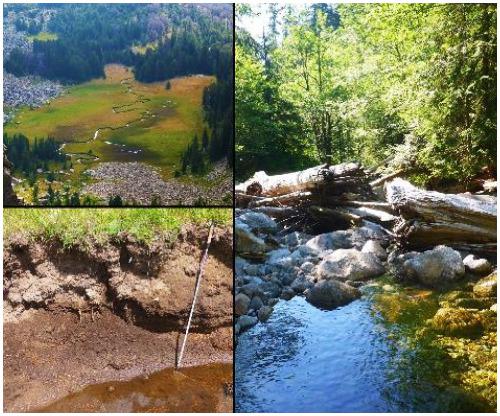当前位置:
X-MOL 学术
›
Earth Surf.Process. Land.
›
论文详情
Our official English website, www.x-mol.net, welcomes your
feedback! (Note: you will need to create a separate account there.)
Geomorphology and Climate Interact to Control Organic Carbon Stock and Age in Mountain River Valley Bottoms
Earth Surface Processes and Landforms ( IF 2.8 ) Pub Date : 2020-04-19 , DOI: 10.1002/esp.4855 Daniel N. Scott 1 , Ellen Wohl
Earth Surface Processes and Landforms ( IF 2.8 ) Pub Date : 2020-04-19 , DOI: 10.1002/esp.4855 Daniel N. Scott 1 , Ellen Wohl
Affiliation

|
24 Organic carbon (OC) in valley bottom downed wood and soil represents a large, 25 dynamic, and poorly quantified pool of carbon whose distribution and residence time affects 26 global climate. We compare four disparate mountain river basins to show that mountain river 27 valley bottoms store substantial OC stocks in floodplain soil and downed wood (127.3 -37.4 +24.5 28 MgC/ha, n = 178). Although soil OC is generally young (185 -75 +269 yr BP, n = 121), soil burial, 29 regulated by geomorphic processes, preserves old OC. Statistical modeling of OC stocks 30 suggests that biogeomorphic processes and the legacy of past erosion regulate the modern 31 distribution of OC in river networks. Our results suggest that although mountain rivers may 32 accumulate large OC stocks relatively rapidly, those stocks are highly sensitive to alterations in 33 soil and wood retention, implying both shortand long-term feedbacks between retentiveness 34 and the distribution of OC between the land and atmosphere. 35 Plain Language Summary 36 Carbon stored on the land has the potential to be released to the atmosphere and act as a 37 greenhouse gas, influencing global climate. To predict future climate, it is imperative to 38 understand where and how much carbon is stored across the landscape to understand how much 39 carbon might be released to and/or sequestered from the atmosphere in the future. We quantify 40 carbon storage in downed wood and soil in mountain river valley bottoms, finding that mountain 41 river valley bottoms are high magnitude carbon storage zones on the landscape, and that the 42 legacy of past glaciation, climate, and modern erosional and depositional processes regulate the 43 age and quantity of stored OC. Our results imply that human actions can change how much 44 carbon is stored in mountain river valley bottoms, and how it is stored there. Understanding the 45 distribution of carbon across the landscape, especially in carbon-rich zones such as valley 46 bottoms, requires an understanding of both the historic and modern processes shaping the 47 landscape and vegetation. 48
中文翻译:

地貌和气候相互作用控制山区河流谷底的有机碳储量和年龄
24 谷底倒下的木材和土壤中的有机碳 (OC) 代表了一个大型的、 25 动态的、量化不佳的碳库,其分布和停留时间影响 26 全球气候。我们比较了四个不同的山区河流流域,表明山区河流 27 谷底在漫滩土壤和倒塌的木材中储存了大量 OC 库(127.3 -37.4 +24.5 28 MgC/ha,n = 178)。尽管土壤 OC 通常是年轻的 (185 -75 +269 yr BP, n = 121),但受地貌过程调节的土壤埋藏 29 保留了旧的 OC。OC 库 30 的统计模型表明,生物地貌过程和过去侵蚀的遗产调节了 31 河流网络中 OC 的现代分布。我们的结果表明,虽然山区河流可能 32 相对较快地积累了大量的 OC 库,这些种群对 33 土壤和木材保持力的变化高度敏感,这意味着在保持力 34 与土地和大气之间 OC 分布之间存在短期和长期反馈。35 简明语言摘要 36 储存在土地上的碳有可能被释放到大气中,并成为 37 温室气体,影响全球气候。为了预测未来的气候,38 必须了解整个景观中碳储存的位置和数量,以了解未来有多少 39 碳可能会释放到大气中和/或从大气中隔离。我们量化了山区河谷底部倒下的木材和土壤中的 40 碳储存,发现山区 41 河谷底部是景观上的高强度碳储存区,42 过去冰川、气候、现代侵蚀和沉积过程调节了 43 年代和储存 OC 的数量。我们的结果意味着人类的行为可以改变 44 碳在山区河流谷底的储存量以及它在那里的储存方式。了解 45 碳在整个景观中的分布,尤其是在 46 谷底等富含碳的区域,需要了解塑造 47 景观和植被的历史和现代过程。48 需要了解塑造 47 个景观和植被的历史和现代过程。48 需要了解塑造 47 个景观和植被的历史和现代过程。48
更新日期:2020-04-19
中文翻译:

地貌和气候相互作用控制山区河流谷底的有机碳储量和年龄
24 谷底倒下的木材和土壤中的有机碳 (OC) 代表了一个大型的、 25 动态的、量化不佳的碳库,其分布和停留时间影响 26 全球气候。我们比较了四个不同的山区河流流域,表明山区河流 27 谷底在漫滩土壤和倒塌的木材中储存了大量 OC 库(127.3 -37.4 +24.5 28 MgC/ha,n = 178)。尽管土壤 OC 通常是年轻的 (185 -75 +269 yr BP, n = 121),但受地貌过程调节的土壤埋藏 29 保留了旧的 OC。OC 库 30 的统计模型表明,生物地貌过程和过去侵蚀的遗产调节了 31 河流网络中 OC 的现代分布。我们的结果表明,虽然山区河流可能 32 相对较快地积累了大量的 OC 库,这些种群对 33 土壤和木材保持力的变化高度敏感,这意味着在保持力 34 与土地和大气之间 OC 分布之间存在短期和长期反馈。35 简明语言摘要 36 储存在土地上的碳有可能被释放到大气中,并成为 37 温室气体,影响全球气候。为了预测未来的气候,38 必须了解整个景观中碳储存的位置和数量,以了解未来有多少 39 碳可能会释放到大气中和/或从大气中隔离。我们量化了山区河谷底部倒下的木材和土壤中的 40 碳储存,发现山区 41 河谷底部是景观上的高强度碳储存区,42 过去冰川、气候、现代侵蚀和沉积过程调节了 43 年代和储存 OC 的数量。我们的结果意味着人类的行为可以改变 44 碳在山区河流谷底的储存量以及它在那里的储存方式。了解 45 碳在整个景观中的分布,尤其是在 46 谷底等富含碳的区域,需要了解塑造 47 景观和植被的历史和现代过程。48 需要了解塑造 47 个景观和植被的历史和现代过程。48 需要了解塑造 47 个景观和植被的历史和现代过程。48











































 京公网安备 11010802027423号
京公网安备 11010802027423号